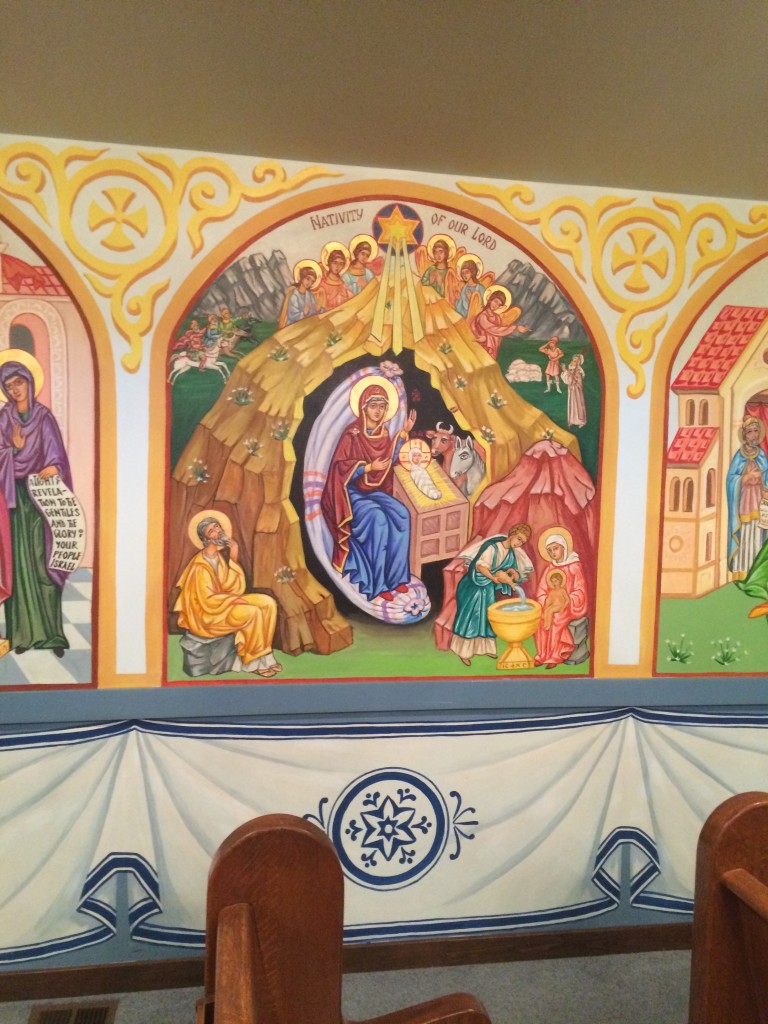Symbolism: The Nativity Icon

I never thought that going to Matins would generate so many blog posts! So…today I sat next to this icon of the Nativity:
In the centre of the icon is Mary the Theotokos, with the infant Christ in a manger, together with some animals (“The ox knows his owner, and the donkey his master’s crib” – Isaiah 1:3). These figures are not in a stable, but in a cave, which reflects the Eastern tradition as well as the practice of the time for keeping animals. Above the cave are the other well-known nativity characters: angels, shepherds, and wise men following the star.
However, what I didn’t understand were the scenes depicted on the bottom-left and bottom-right corners of the icon. In the bottom-left we see St. Joseph sitting by himself with an odd look on his face and in the bottom-right there’s an illustration of what looks to me like an infant baptism taking place. What do these scenes represent?
The Baby Bath
It is quite common in icons to have a character appear multiple times, to illustrate different stages of the story being told in the icon. In this case, the scene in the bottom-right corner which reminded me of an infant baptism, actually depicts a midwife preparing to wash the baby Christ shortly after His birth. The rendition of this scene in the icon is to emphasize that Jesus was fully human and came into this world through a real, physical birth.
These servants are not mentioned in Scripture, but are in a very early document called the Protoevangelium of James, written somewhere between AD 140-170. According to the text, St. Joseph brought along the midwife and Salome, the mother of James and John, who was one of the women to discover the empty tomb.
Why so glum, Joe?
It turns out that St. Joseph is purposefully set apart from the manger scene to emphasize the fact that he is not the natural father of Jesus and was not involved in His conception.
Apparently, the odd look on St. Joseph’s face is because he has is pondering and even doubting the virgin birth. Joseph is seen talking to a hunched old man, symbolic of the Devil, who is trying to fill his head with these doubts, which he ultimately rejects. These details are also found in the Protoevangelium of James.
A few other bits and pieces…
As I was researching this icon, I also came across a few other interesting factoids concerning this icon of which I was formally unaware:
The cave and swaddling clothes each foreshadow Christ’s tomb and burial clothes.
The rough rocks seen throughout the icon depict the fallen world into which Christ was born.
There are three rays of light coming out of the star which are representative of the Trinity.
The wise men are often depicted in a way which represents all generations. There’s often one wise man without a beard to represent the young, another with a black beard represents adults, with the last one sporting a white beard to represent the elderly.
Sometimes there is a tree somewhere in the icon which represents that old favourite from Children’s Liturgy, the Jesse tree, a symbol of Isaiah’s prophecy that “A shoot shall sprout from the stump of Jesse” – Isaiah 11:1-2.
I never cease to be surprised at the theological depths hidden in icons which I pass by each day in blissful ignorance!
